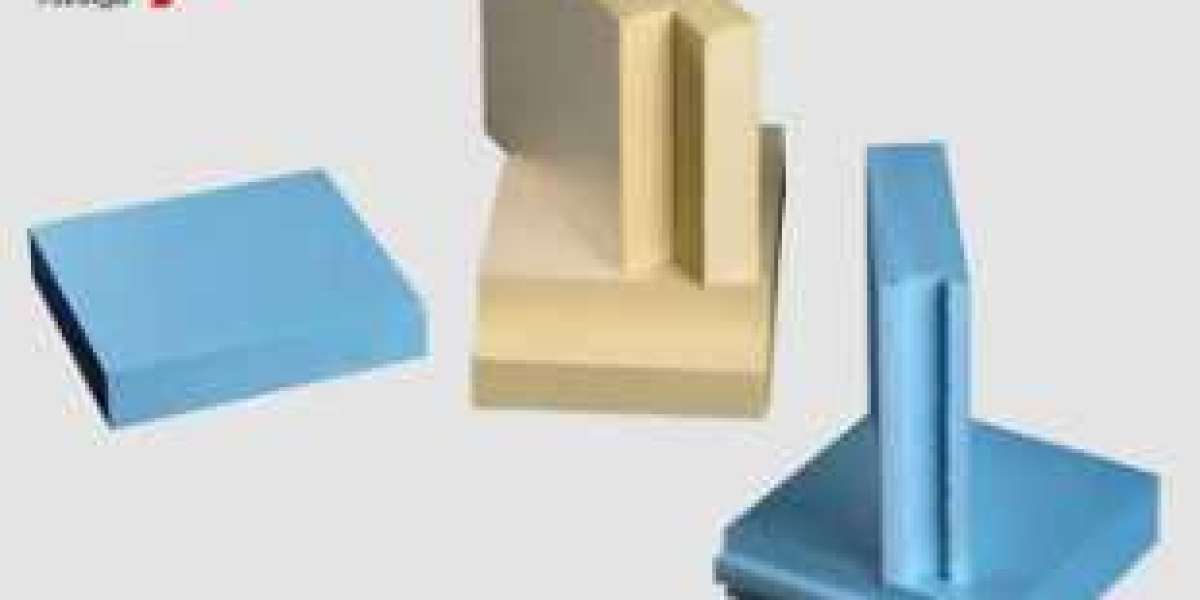Introduction to XPS Foam Board
Welcome to the world of XPS Foam Board production! If you're looking to delve into this fascinating field or simply want to expand your knowledge, you've come to the right place. In this comprehensive guide, we will take you on a journey through the ins and outs of mastering XPS Foam Board production.
XPS foam board is a versatile material that has gained immense popularity in various industries due to its exceptional properties and countless applications. From construction projects to arts and crafts, this lightweight yet durable board offers an array of benefits that make it stand out from other materials.
In this article, we'll explore the advantages of using XPS foam board, delve deep into its production process step by step, discuss quality control measures and testing methods, explore common applications across different industries, share valuable tips for successful production, and wrap up with some final thoughts.
So fasten your seatbelts as we embark on an exciting journey into the world of XPS Foam Board Production - brought to you by Feininger - where innovation meets excellence! Let's get started!
Benefits of Using XPS Foam Board
XPS foam board, also known as extruded polystyrene foam board, offers a multitude of benefits that make it an excellent choice for various applications. One key advantage is its exceptional thermal insulation properties. The closed-cell structure of XPS foam boards helps to minimize heat transfer, making them highly effective in maintaining desired temperatures.
In addition to thermal insulation, XPS foam boards are moisture-resistant and waterproof. This feature makes them ideal for use in damp or humid environments such as basements, bathrooms, and swimming pool areas. Unlike other materials like wood or gypsum board, XPS foam boards do not absorb water or promote mold growth.
Another benefit of using XPS foam board is its high compressive strength. These boards can withstand heavy loads without significant deformation or damage. This property makes them suitable for load-bearing applications such as foundations under concrete slabs or roadways.
Furthermore, XPS foam boards are lightweight and easy to handle compared to traditional building materials like concrete blocks or bricks. This characteristic facilitates faster installation times and reduces labor costs.
Moreover, the dimensional stability of XPS foam board ensures that it retains its shape over time without warping or shrinking under normal conditions. This stability contributes to the long-term durability of structures built with these boards.
Additionally, XPS foam boards have excellent resistance to chemicals and solvents commonly found in construction environments. They are also resistant to insects and rodents due to their non-nutritious nature.
From an environmental perspective, XPS foam boards can be recycled into new products at the end of their lifespan if appropriate recycling facilities exist in your area.
In conclusion,XPS Foam Board offers a wide range of benefits including superior thermal insulation properties,freedom from moisture-related issues,long-lasting performance,and ease of handling during installation.
It's versatility makes it suitable for various applications across different industries.
If you're considering a material that combines efficiency,durability,and sustainability,XPS foam board is an excellent choice.
The Production Process: Step by Step
Producing XPS foam board requires a meticulous and precise process. Let's dive into the step-by-step production procedure to get a better understanding of how this remarkable material is made.
1. Raw Material Preparation:
The first step involves gathering the necessary raw materials - primarily polystyrene beads, blowing agents, and additives. These components are carefully measured and mixed in specific proportions to achieve the desired properties.
2. Pre-expansion:
Next, the mixture is heated and pre-expanded using steam or hot air. This causes the polystyrene beads to expand and fuse together, forming a cellular structure with closed cells.
3. Conditioning:
After pre-expansion, the expanded beads are cooled down to room temperature through a conditioning process. This helps stabilize their size for further processing.
4. Mat Formation:
The conditioned beads are then fed onto a conveyor belt where they pass through rollers that flatten them into a continuous mat or sheet of uniform thickness.
5. Continuous Extrusion:
In this stage, the mat enters an extruder machine where it is exposed to high temperatures and pressure. The heat melts the surface of the mat while applying pressure ensures its bonding at molecular levels.
6. Cooling Section:
After extrusion, cooling sections cool down both sides of XPS foam board simultaneously so that it solidifies without deformation while providing thermal insulation performance.
7. Trimming Cutting
Once cooled-down completely,t he boards go through trimming stations where excess edges are cut off ensuring proper dimensions as per requirements. Followed by cutting machines which divide these sheets into required sizes for packaging purposes or further applications.
8. Quality Control
Throughout each stage of production, strict quality control measures are implemented to ensure consistent product quality. The density,test reports,and mechanical properties tests must be done on random samples from every batch produced before shipping them out.
By following these steps diligently,the production process of XPS foam board is completed.
Quality Control and Testing
Ensuring the highest level of quality is crucial in XPS foam board production. Without proper quality control measures, even the most meticulously crafted boards can fall short in performance and durability. That's why rigorous testing procedures are an integral part of the production process.
One essential aspect of quality control is material testing. Samples from each batch undergo comprehensive analysis to confirm that they meet industry standards for density, compressive strength, thermal conductivity, and water absorption. By conducting these tests, manufacturers can identify any deviations early on and make necessary adjustments to ensure consistency across all batches.
Another critical component of quality control is dimensional accuracy. XPS foam boards must be cut precisely to achieve uniform thickness throughout. Any variations could negatively impact their insulating properties or structural integrity. To address this, manufacturers employ advanced cutting technologies such as computer numerical control (CNC) machines that provide accurate measurements within tight tolerances.
In addition to material testing and dimensional accuracy checks, other factors like surface finish and visual defects are also assessed during quality control inspections. This ensures that the finished product not only meets performance specifications but also looks aesthetically pleasing.
By implementing robust quality control measures at every stage of production, manufacturers can confidently deliver reliable and high-performing XPS foam boards to their customers.
Common Applications and Uses of XPS Foam Board
XPS foam board, also known as extruded polystyrene, is a versatile material that finds its application in various industries. Due to its excellent thermal insulation properties, durability, and moisture resistance, it has become a popular choice for both residential and commercial projects.
In the construction industry, XPS foam board is widely used for insulation purposes. It can be used in walls, roofs, floors, and foundations to provide effective thermal protection. Its closed-cell structure helps prevent heat transfer through conduction and convection.
Another common use of XPS foam board is in the packaging industry. Its lightweight nature makes it ideal for protecting delicate items during transportation. The high compressive strength ensures that the products remain safe from damage even under heavy loads.
XPS foam board also proves useful in creative projects such as model making or crafting props for movies or theater productions. Its ease of cutting and shaping allows artists to bring their imaginative ideas to life with precision.
Additionally, XPS foam boards find applications in signage manufacturing where they serve as a sturdy base for adding graphics or lettering. The smooth surface provides an excellent canvas for painting or printing.
The versatility of XPS foam board makes it suitable for a wide range of applications across industries. Whether you need insulation for your home or require a reliable packaging solution or want to explore your artistic talents – this material offers endless possibilities!
Tips for Successful Production
1. Proper Equipment and Tools: Investing in high-quality equipment and tools is essential for successful XPS foam board production. Make sure you have the right cutting machines, extruders, molds, and other necessary equipment to ensure efficiency and precision in your production process.
2. Technical Expertise: Having a skilled team with expertise in working with XPS foam board is crucial. Ensure that your staff understands the technical aspects of the production process, including temperature control, pressure settings, and timing requirements.
3. Quality Materials: Using top-grade raw materials is key to producing high-quality XPS foam boards. Opt for reputable suppliers who can provide consistent quality materials that meet industry standards.
4. Strict Adherence to Safety Protocols: Safety should always be a top priority in any manufacturing facility. Implement strict safety protocols such as proper ventilation systems, personal protective equipment (PPE), and regular training programs to minimize risks and ensure a safe working environment.
5. Continuous Improvement: Regularly assess your production processes to identify areas where improvements can be made. This could involve streamlining workflows, optimizing energy usage, or implementing new technologies to enhance efficiency and reduce waste.
6. Quality Control Measures: Establish robust quality control measures throughout the entire production cycle to detect any deviations from desired specifications early on. Conduct regular inspections at various stages of production to maintain consistency in product quality.
7. Environmental Considerations: As environmental awareness continues to grow, incorporating sustainable practices into your production processes can set you apart from competitors while reducing your carbon footprint.
Remember that mastering XPS foam board production takes time and experience; don't hesitate to seek advice from industry experts or attend workshops/seminars focused on improving your knowledge and skills in this field!
Conclusion
Mastering the production of XPS foam board is a crucial skill for manufacturers and suppliers in various industries. Feininger, with its expertise and advanced technology, has revolutionized the production process of XPS foam board.
Throughout this comprehensive guide, we have explored the benefits of using XPS foam board, delved into the step-by-step production process, highlighted quality control measures, and examined common applications and uses. We have also provided valuable tips for successful production.
By mastering each aspect discussed in this guide, manufacturers can ensure that their XPS foam boards meet high standards of quality while offering exceptional performance properties. Whether it's insulation for buildings or packaging solutions for sensitive goods, Feininger's XPS foam boards are an excellent choice.
Remember to always prioritize safety procedures during production and adhere to local regulations. This will not only guarantee product excellence but also contribute to sustainability efforts by reducing waste and energy consumption.
Feininger continues to innovate in the field of XPS foam board production, pushing boundaries through research and development efforts. With advancements in technology and growing demand for efficient insulation materials worldwide, there is no doubt that mastering XPS foam board production is essential for future success.
So go ahead – equip yourself with knowledge about Feininger's cutting-edge techniques! Embrace the vast potential offered by XPS foam boards in your industry today!








